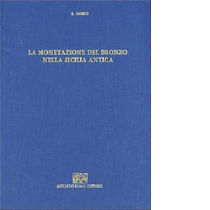Fine Coins Showcase
Antiquities Showcase
Show Empty Categories
Shop Search
Shopping Cart
My FORVM
Contact Us
About Forum
Shopping at Forum
Our Guarantee
Payment Options
Shipping Options & Fees
Privacy & Security
Forum Staff
Selling Your Coins
Identifying Your Coin
FAQs
zoom.asp
Home ▸ Catalog ▸ |Greek Coins| ▸ |Geographic - All Periods| ▸ |Sicily||View Options:   | | | | | | The coins of Ancient Greek Sicily are considered among the finest numismatic works of art ever produced. Superb examples may cost tens or even hundreds of thousands of dollars. Forum's selections include some more affordable examples. |


Located on a plateau overlooking Sicily's southern coast, Akragas was founded c. 582 B.C. by colonists from Gela. It grew rapidly, becoming second only to Syracuse in importance on Sicily but was sacked by Carthage in 406 B.C. and never fully recovered. It was renamed Agrigentum after it fell to Rome in 210 B.C.GI98095. Cast bronze tetras, Westermark 1979 2; Westermark Akragas 526; Calciati I p. 145, 6; SNG ANS 1018; HGC 2 127 (R1), aF, dark green patina, 9.004g, 16.9mm long, weight 9.004 g, maximum diameter 17.25 mm, die axis 0o, Akragas (Agrigento, Sicily, Italy) mint, c. 450 - 440 B.C.; cast somewhat tooth-shaped flattened cone form, three pellets (mark of value) arranged in a triangle on flat top, heads and necks of two eagles back-to-back facing outwards on one side, crab opposite; rare; $140.00 (€131.60)
Selinous, Sicily, c. 450 - 440 B.C.


Selinous was once one of the most important Greek colonies in Sicily. In 409 B.C., the Carthaginians attacked with a vast army believed to include at least 100,000 men. Selinus, with a population of about 30,000 excluding slaves, was unprepared and an auxiliary force promised by Syracuse, Agrigentum and Gela did not arrive. The Selinuntines defended themselves with courage, and after the walls were breached, continued to fight from house to house. After tens days the city fell. Of the citizens, 16,000 were slain and 5,000 made prisoners, but more than 2,600 escaped to Agrigento.GI112252. Bronze cast tetras, Calciati I p. 235, 4; SNG Lloyd 1272; HGC 2 1233 (R1); BMC Sicily -; SNG Cop -; SNG ANS -; SNG Munchen -; SNG Morcom -; SNG Tüb -, F, dark patina, spots of corrosion, scratches, weight 11.855 g, maximum diameter 20.4 mm, die axis 180o, Selinus mint, 450 - 440 B.C.; obverse facing head of Medusa (gorgoneion), anepigraphic; reverse wild celery (selinon) leaf, three pellets (mark of value) around, anepigraphic; rare; $125.00 (€117.50)
Syracuse, Sicily, Second Democracy, 466 - 405 B.C.


Following Heron's death, democracy was restored in 466 B.C. Similar to at Athens, the polis was governed by a council and popular assembly with an executive consisting of elected generals or strategoi. Syracuse fought against Athens 427 - 424 B.C. and again 415 - 413 B.C.; ultimately Syracuse was victorious. With further reforms by Diocles, the democratic nature of Syracuse's political structure was further strengthened.GI114975. Bronze hemilitron, Calciati II p. 45, 19; SNG Cop 696; SNG ANS 405; SNG Morcom 682; SNG Munchen 1103; HGC 2 1479 (S), F, fine style, porous, earthen deposits, marks/ scratches, sprue remnants, weight 3.637 g, maximum diameter 15.6 mm, die axis 315o, Syracuse mint, c. 415 - 405 B.C.; obverse head of nymph Arethusa left, hair bound in ampyx and sphendone; reverse wheel with four spokes, ΣY-PA in upper half divided by spoke, two dolphins facing down and inward between the lower spokes; ex Classical Numismatic Group mail bid 78 (14 May 2008), lot 124 (part of); $90.00 (€84.60)
La Monetazione Del Bronzo Nella Sicilia Antica


Arnaldo Forni Editore. 1985 reprint of the original 1927 publication. The bronze coinage of ancient Sicily.BK23928. La Monetazione Del Bronzo Nella Sicilia Antica by E. Gabrici, in Italian, hardcover, age and shelf wear, 213 pages, 10 plates, international shipping at actual cost of shipping; $70.00 (€65.80)
Syracuse, Sicily, Hieron II, 275 - 215 B.C.


Hieron II was tyrant and then king of Syracuse, c. 270 to 215 B.C. His rule brought 50 years of peace and prosperity, and Syracuse became one of the most renowned capitals of antiquity. He enlarged the theater and built an immense altar. The literary figure Theocritus and the philosopher Archimedes lived under his rule. After struggling against the Mamertini, he eventually allied with Rome. MA113876. Bronze AE 27, cf. Calciati p. 374, 193; SNG ANS 909 ff.; SNG Cop 843; BMC Sicily p. 215, 565 ff.; HGC 2 1547 (S) (all refs. various controls), weight 14.979 g, maximum diameter 27.2 mm, die axis 315o, Syracuse mint, c. 240 - 215 B.C.; obverse laureate head of Hieron left, beardless, uncertain control symbol behind; reverse cavalryman prancing right, helmeted, wearing military garb, chlamys flying behind, couched spear in right hand, reins in left hand, IEPΩNOΣ in exergue, control symbols (if any) obscure; $27.00 (€25.38)
REFERENCES|
Page created in 1.407 seconds.










